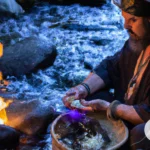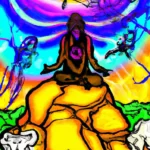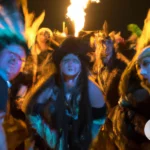Shamanism is an ancient spiritual practice that has been around for thousands of years and is still practiced by many people today. Core shamanism is a type of shamanism that involves accessing the spiritual realms through trance states to connect with spirit allies, receive guidance, and perform healing practices. In this article, we will explore the basic principles of core shamanism, including the three worlds, spirit allies such as power animals and spirit guides, shamanic journeying, and healing practices like extraction, soul retrieval, and psychopomp. So, let’s dive into the fascinating world of core shamanism and discover how it can provide a deeper, more meaningful connection with the spiritual forces all around us.
The Three Worlds

In Core Shamanism, the universe is divided into three distinct worlds – the Upper World, the Middle World, and the Lower World. Each world has its own unique characteristics and inhabitants that can be interacted with through shamanic journeying. The Upper World is the home of the spirit guides, and it is accessed through meditation or ascension. In contrast, the Lower World is the domain of the power animals, which are animal spirit allies that provide guidance and protection. This underworld is an entryway to the spiritual plane, which is lower vibrational than the physical plane. The Middle World is where we live and interact with the physical world, which makes it a place of immense power as it connects us to our senses and worldly knowledge. By journeying through the three worlds, a shaman can gain insight, wisdom, and knowledge from the spirits that reside there.
Upper World
In Core Shamanism, the Upper World is considered as one of the three worlds that a shaman can journey to obtain guidance, healing, and wisdom. This realm is often associated with celestial or heavenly energies and is inhabited by compassionate helping spirits such as angels, ascended masters, and deceased loved ones. To access the Upper World, a shaman would typically use rhythmic drumming or chanting and enter into a trance state. Once there, a variety of practices can be performed, including:
| Practice | Description |
|---|---|
| Meeting Spirit Guides | A shaman can connect with spirit guides who can offer guidance and teachings. They may appear in human or animal form or as energetic beings of light. |
| Exploring the Akashic Records | The Akashic Records contain the history of every soul and can offer a wealth of insight and knowledge into one’s past lives, current life, and future possibilities. |
| Receiving Messages and Insights | During a journey to the Upper World, a shaman may receive important messages, guidance, or insights from their spirit guides or other compassionate spirits that can offer clarity and direction. |
It’s important to note that while the Upper World can be a source of great wisdom and insight, it’s not the only realm a shaman can journey to. It’s essential to have a balanced understanding of the different worlds and their unique qualities to ensure a well-rounded practice. Understanding the Upper World and its inhabitants can provide a shaman with a broader perspective on their healing practices and enable them to offer more effective guidance to their clients.
To learn more about Core Shamanism and its various practices, you can check out resources such as core-shamanism, understanding shamanic journeying in Core Shamanism, and power animals in Core Shamanism.
Middle World
is the plane of existence where everyday reality takes place. It’s where we spend most of our physical life. According to core shamanism, the Middle World is divided into three parts – the right-side reality, the left-side reality, and the middle reality. These divisions aren’t geographical but rather spiritual. The right-side reality is commonly associated with the past, and the left-side reality is commonly associated with the future. The middle reality is considered the present and where we currently exist.
The middle world is where we encounter the issues that we face daily, including illness, relations, stress, and anxiety. It’s also where we can discover guidance and support for ourselves. Shamans believe that the middle world is the easiest area to access, and many of their practices are focused on the middle world.
Shamans use many tools to travel and navigate through the middle world, including the use of drums, rattles, and other ceremonial instruments. They can also use visualization techniques to travel to different parts of the middle world while remaining in a trance state.
One of the critical aspects of the middle world is the presence of power spots. These are physical locations on the earth where spiritual energy concentrates. Power spots may include geographic or human-made nature features such as mountains, lakes, or pyramids. They’re often significant places for ceremonies and can provide healing, guidance, and restoration.
The middle world is an essential component of core shamanism. It’s where most people spend their physical life and is therefore the easiest area to access. Shamans often focus their practices on the middle world to help people heal and overcome everyday challenges. By connecting with power spots in the middle world, shamans can find guidance and access healing energy.
Lower World
In Core Shamanism, the Lower World is the place where shamanic practitioners go to seek guidance and connect with their spirit helpers. This world is often depicted as a cave, a forest, or even an underground realm. The Lower World is associated with the subconscious and represents a journey into the depths of oneself.
Within the Lower World, one can encounter spirit animals who offer guidance and protection. These spirit animals are often seen as benevolent and wise, possessing a deep understanding of the ways of the world. They may also be seen as representing aspects of the unconscious mind.
In addition to spirit animals, the Lower World is home to ancestral spirits who may offer assistance and support. These spirits can offer invaluable insight into one’s family history and provide guidance in matters of family and legacy.
Getting to the Lower World requires a journey that involves moving through a tunnel or a natural opening in the earth. Once there, one can explore the landscape and seek out their spirit helpers. Journeying to the Lower World often involves specific shamanic practices such as drumming, chanting, or using other shamanic tools.
The Lower World represents an important aspect of Core Shamanism, offering a rich source of insight, wisdom, and guidance. By delving into the subconscious and tapping into the power of spirit animals and ancestral spirits, practitioners can gain a deeper understanding of themselves, their families, and the world around them.
If you want to read more about the history of Core Shamanism, you can click on this link: Core Shamanism History. If you are interested in learning more about shamanic tools used in Core Shamanism, click on this link: Shamanic Tools and Core Shamanism.
Spirit Allies
In Core Shamanism, having strong connections with spirit allies is crucial to effectively navigating the three worlds and performing healing practices. Spirit allies are entities that are believed to help and guide the shaman on their journey, providing insight and protection along the way. Power animals are one of the most common types of spirit allies and are seen as protectors and helpers in the shaman’s daily life. Spirit guides, on the other hand, are usually human-like beings that offer wisdom and counsel. Building a relationship with one’s spirit allies is an ongoing process that requires dedication and commitment to recognize their presence and messages. By cultivating this connection, a shaman can harness the guidance and strength of their spirit allies to carry out powerful practices that can lead to transformative results.
Power Animals
Power animals are frequently mentioned in shamanic practice, as they are considered to be one of the most important spirit allies for a shaman. They are believed to be spirits that take the form of animals, birds, or sometimes even insects, and they assist the soul on its journey in the shamanic realm.
A power animal is not just any animal that you feel drawn to, but rather a specific and personal spirit helper. During a shamanic journey, the shaman will often seek out their power animal to guide them through the other worlds.
The choice of the power animal is not arbitrary but is determined by the shaman’s unique connection to it. The power animal is often seen as a reflection of the shaman’s own personality traits and can provide them with strength and guidance in their lives.
The power animal can also help in identifying and understanding the root causes of issues such as depression, anxiety, or physical pains, and provide guidance on how to overcome them.
It is essential to cultivate a strong relationship with one’s power animal as they can provide a deep sense of protection and companionship throughout life. Through this relationship, they can help us connect to our inner wisdom, enabling us to heal ourselves and offer our healing powers to others.
Power animals play a significant role in core shamanism, serving as personal spirit guides and allies. A shaman’s power animal is not a random choice but rather a reflection of the shaman’s personality, providing strength, guidance, and protection. The relationship with one’s power animal is essential and requires cultivation to gain its full benefits.
Spirit Guides
are entities that serve as personal mentors and helpers in spiritual matters. A Spirit Guide is believed to be a person’s own personal guru, who provides spiritual guidance and emotional support. It’s not uncommon for practitioners of Core Shamanism to have multiple Spirit Guides. These beings can manifest themselves in many forms, such as animals, humans, or even mythological creatures. It is essential to build a strong relationship of trust and respect with these entities to access their guidance.
The role of a Spirit Guide in shamanic practice is to mentor the shaman on their journey and offer guidance about important spiritual issues. They act as a teacher or a guide and can help the practitioner navigate the spiritual realm. In addition to their spiritual guidance, Spirit Guides are believed to help heal emotional and physical pain.
Shamanic practitioners are encouraged to communicate with their Spirit Guides daily. This communication can often take the form of meditation, prayer, or visualization. It is imperative to be respectful while communicating with your Spirit Guide by approaching them with reverence and an open mind.
By regularly communicating with your Spirit Guides, you can access their knowledge, wisdom, power, and protection. It is essential to build a positive and respectful relationship with these entities to benefit from their guidance. Incorporating Spirit Guides into your shamanic practice can be a powerful tool for spiritual growth and healing.
Core Shamanism teaches the importance of building strong relationships with Spirit Guides to gain a better understanding of the self and the world around us. Practitioners of Core Shamanism often perform ceremonies to honor their Spirit Guides and express gratitude for their guidance. They also enlist the help of these entities during healing practices, such as Extraction, Soul Retrieval, and Psychopomp. The use of Spirit Guides is an integral part of Core Shamanism, providing an unprecedented opportunity for personal and spiritual development.
Shamanic Journeying

Shamanic Journeying is a crucial practice in Core Shamanism, as it allows the shaman to enter an altered state of consciousness and travel to the three worlds. The first step in journeying is to create a safe and sacred space, which may involve smudging with herbs like sage or chanting. Then the shaman must enter a trance state, which can be achieved through drumming, rattling, or another repetitive sound. In this state, the shaman can connect with their spirit allies, including power animals and spirit guides, and explore the three worlds. It’s important for the shaman to keep a journal of their journeys and experiences, as well as to take time for integration and grounding afterward. Shamanic journeying is a powerful tool for personal growth and healing. To learn more about the lower world in Core Shamanism, visit this link.
Entering Trance State
Entering a trance state is the first step towards shamanic journeying. This state of mind allows a shaman to enter the spirit world and connect with their spirit allies. There are many ways to enter a trance state, including drumming, chanting, dancing, and using entheogenic plants. Here are some methods often used:
| Method | Description |
|---|---|
| Drumming | Repetitive drumming at a steady rhythm is one of the most common methods to enter a trance state. The sound of the drumming helps to focus the mind and induces an altered state of consciousness. The shaman may either participate in the drumming or listen to another shaman or musician play. |
| Chanting | Chanting is a method that involves repetitive singing or reciting of a phrase or mantra. The sound and rhythm of the chant help to focus the mind and allow the individual to enter a meditative state. The shaman may also use harmonic chanting, which involves chanting different notes to create an overtone that can induce a trance. |
| Dancing | Dancing is another method that the shaman can use to enter a trance state. The repetitive movement of the body and the rhythm of the music help to focus the mind and induce an altered state of consciousness. The shaman may dance alone or with others, and the dance may be spontaneous or follow a specific choreography. |
| Entheogenic Plants | Many shamanic traditions use entheogenic plants, such as ayahuasca, peyote, or psilocybin mushrooms, to enter a trance state. These plants contain psychoactive compounds that induce an altered state of consciousness, which the shaman can use to enter the spirit world. The use of these plants may be legal or illegal, depending on the culture and laws of the region. |
It’s important to note that entering a trance state should be done with caution and preparation. The shaman should create a safe and sacred space for the journey, free from any distractions or interruptions. They should also set an intention for the journey and ask for protection and guidance from their spirit allies. With practice and experience, the shaman can learn to enter a trance state more easily and navigate the spirit world with confidence.
Exploring the Three Worlds
To explore the three worlds, one needs to enter a trance state. During this altered state of consciousness, the shamanic practitioner can journey to the three realms and communicate with spirits. Let’s delve into each realm and what they represent.
- Upper World: The upper world is where the spirits of light and higher consciousness reside. It is often associated with the sky, heaven, and celestial beings. During a shamanic journey, one may encounter spirit guides, angels, and ascended masters in the upper world. This realm offers higher wisdom, knowledge, and spiritual insight.
- Middle World: The middle world is the realm of the physical plane where we reside. It is the realm of material reality, mundane experiences, and the five senses. However, during a shamanic journey, it can take on a magical quality.One may encounter spirit animals, guides, and even deceased loved ones in this realm. It is a place where one can gain valuable insights and healing.
Subscribe to Our Newsletter
Sign up to receive the latest news and updates.
- Lower World: The lower world is associated with the Earth and its underground. It represents the subconscious, instincts, and primal energies. In shamanism, it is believed to be the realm of power animals and teachers who assist the practitioner in reconnecting with their true nature. It is also a realm where one can retrieve lost parts of their soul.
During a shamanic journey, the practitioner may enter one or all of these realms depending on their intention. The journey can be initiated through drumming, chanting, or visualization. The goal is to simply be open to the experience and trust in the guidance of your spirit allies. Through exploring the three worlds, one can access profound insights, healing, and transformation.
Healing Practices
In core shamanism, healing practices involve various techniques to restore balance and harmony to a person’s mind, body, and spirit. One of the key practices is extraction, where the shaman removes intrusive energies from the person’s energy field. This technique is particularly useful for those experiencing physical or emotional pain that can’t be explained through conventional means. Another important technique is soul retrieval, where the shaman helps the person reclaim parts of their spirit that may have been lost due to trauma or dissociation. This practice can be immensely healing and transformative. Finally, shamanism also recognizes the importance of psychopomp, where the shaman works with spirits to assist the dying in crossing over to the afterlife. Through these practices, shamanism offers a unique and powerful approach to healing that focuses on the interconnectedness of all things and the restoration of wholeness.
Extraction
Extraction is one of the primary healing practices in Core Shamanism. It involves the removal of intrusive energies or blockages from a person’s energy body or spirit. These intrusions can come in various forms such as emotional distress, illness, or negative thought patterns.
In Core Shamanism, shamans use a range of methods for extraction, including sucking, shaking, or pulling, to remove these intrusions. The shaman may use tools such as feathers, crystals, or stones to aid in the removal process.
The extraction process is often preceded by a diagnostic journey, in which the shaman determines the location and nature of the intrusion. Once the intrusion is located, the shaman will focus their intent and use their skills to extract the unwanted energies or blockages.
The process of extraction is often accompanied by various physical and emotional sensations, such as heat or coldness, twitching, or involuntary movement. Patients may also experience emotional releases during the extraction process, such as crying or feeling an intense sense of relief.
Extraction is a powerful healing technique that can bring significant relief to those suffering from intrusive energies or blockages. It is important to note that while extraction can provide immediate relief, the root causes of the intrusion must also be addressed to ensure lasting healing and wellness.
In conclusion, extraction is an essential practice in Core Shamanism that involves the removal of unwanted energies or blockages that can cause emotional, physical, and spiritual distress. This technique provides immediate relief to patients and is often accompanied by physical and emotional releases as well as powerful sensations.
Soul Retrieval
Soul Retrieval is a shamanic healing practice that involves bringing back fragmented pieces of the soul lost due to trauma or other life experiences. This practice involves a shaman journeying into the spiritual realm to connect with the lost soul fragments and return them to the client, allowing them to restore their wholeness.
During soul retrieval, a shaman will enter into a trance state and journey to the client’s past or present time in the spiritual realm. The shaman will then locate the lost soul fragments and communicate with them. Once the shaman has connected with these lost fragments, they will be reintegrated into the client’s soul.
This practice can have profound benefits for clients who have undergone trauma or significant life changes, such as the loss of a loved one, divorce, or a major illness. Integrating these lost soul fragments can help individuals regain vital energy, feel more connected to the present moment, and experience greater emotional stability and mental clarity.
It’s worth noting that soul retrieval is not a substitute for professional medical or psychological treatment and is best done under the guidance of a trained shamanic practitioner.
Soul Retrieval Process
Below is a step-by-step process for performing a soul retrieval:
| 1. | The client shares their story and identifies areas where they feel stuck or lost. |
| 2. | The shaman enters into a trance state and journeys to the spiritual realm. |
| 3. | The shaman locates the lost soul fragments and communicates with them. |
| 4. | The shaman brings back and reintegrates the soul fragments into the client’s soul. |
| 5. | The shaman and client discuss the integration process and strategies for supporting the client’s healing moving forward. |
It’s important to note that although soul retrieval can be a powerful and transformative practice, it’s not always the solution to every problem. It’s essential to consult with a trained shamanic practitioner to determine if soul retrieval is the right course of action for an individual.
Psychopomp
Psychopomp is a term used in core shamanism to describe a spirit guide who helps souls transition from the physical world to the spiritual realm. In many shamanic cultures, it is believed that the soul continues to exist after the body dies and must be guided to its proper place in the afterlife. A psychopomp is a spiritual guide that helps with this transition.
Some psychopomps are known in mythology by different names such as Hades, Anubis, and Charon. In core shamanism, a psychopomp can take on many different forms and can be any spirit guide that has the knowledge and ability to guide souls.
During a psychopomp session, a shaman may use various tools, such as drumming or rattling, to enter a trance state and connect with the spirit world. Once there, the shaman can communicate with the psychopomp and ask it to guide the soul to its rightful place.
There are many different reasons why a person may require a psychopomp. It may be to help a loved one who has recently passed away or to help a lost soul that is stuck in between worlds. Sometimes, a person may feel lost or disconnected in their life, and a psychopomp can help guide them to find their purpose and place in the world.
A psychopomp is an essential aspect of core shamanism and can provide comfort and guidance to those who are seeking a connection with the spirit world. Whether it is helping souls transition from this world to the next or guiding individuals to find their place in life, the psychopomp is a powerful and valuable spirit guide.
Conclusion
The principles of core shamanism offer a profound and transformative way of engaging with the world around us. Whether you are seeking to deepen your spiritual practice, explore new dimensions of consciousness and reality, or find a path of healing and personal growth, shamanic techniques can be an invaluable tool.
At the core of this practice are the Three Worlds, each with their own unique character and energy. By opening ourselves to these realms and their inhabitants, we can connect with spirit allies who can help guide and support us on our journey. Whether through power animals or spirit guides, these teachers offer valuable insights and wisdom that can help us navigate the challenges of life.
Through the practice of shamanic journeying, we can learn to enter a state of trance and explore these realms with clarity and intention. By engaging in this practice on a regular basis, we can refine our ability to listen to the wisdom of our spirit allies and deepen our connection to the spiritual dimensions of the world.
Along with journeying, shamanic healing practices can be used to address a wide range of physical, emotional, and spiritual issues. Extraction, soul retrieval, and psychopomp techniques can help us clear out negative energies, restore lost soul parts, and facilitate the passage of the dead to the afterlife.
As you explore the principles of core shamanism, remember that this is a path of ongoing learning and transformation. By opening yourself to the guidance of your spirit allies and committing to your own growth and healing, you can experience the profound changes that this practice can bring about. May you find joy, inspiration, and wisdom in the rich and vibrant world of shamanic practice.
Frequently Asked Questions
What is Core Shamanism?
Core Shamanism is a modern adaptation of ancient shamanic practices that focuses on the universal principles and techniques of shamanism.
What are the three worlds in Core Shamanism?
The three worlds in Core Shamanism are the Upper World, Middle World, and Lower World. These worlds are accessed through shamanic journeying and are believed to represent different aspects of reality and consciousness.
What is the Upper World?
The Upper World is a realm of spirit and light, often associated with celestial beings and divine forces. It is typically accessed by ascending through a tunnel or stairway.
What is the Middle World?
The Middle World is the realm of ordinary reality, where we experience our daily lives and interact with the physical world. It is accessed through shamanic journeying and provides a gateway to the other worlds.
What is the Lower World?
The Lower World is a realm of earth and nature, often associated with animal spirits and primal energies. It is typically accessed by descending through a tunnel or cave.
What are Power Animals?
Power Animals are animal spirits that serve as guides, protectors, and sources of power for shamans. They are often encountered during shamanic journeying and are believed to embody the qualities and characteristics of their respective animal species.
What are Spirit Guides?
Spirit Guides are non-animal spirits that serve as teachers, helpers, and advisors for shamans. They may take various forms and have different roles, but all are believed to provide guidance and support on the shamanic path.
How do you enter the trance state during shamanic journeying?
The trance state is typically induced through rhythmic drumming or other forms of rhythmic stimulation. This helps to shift the brain into a theta state, where deeper levels of consciousness and perception can be accessed.
What is extraction in shamanic healing?
Extraction is a shamanic healing practice that involves removing spiritual or energetic blockages from a person’s body or energy field. This is typically done through the use of specialized tools, such as a shamanic extraction wand or suction device.
What is soul retrieval in shamanic healing?
Soul retrieval is a shamanic healing practice that involves recovering lost or fragmented parts of a person’s soul or psyche. This is often done through a shamanic journey to the Lower World, where the lost soul parts may be located and retrieved.
What is psychopomp in shamanic healing?
Psychopomp is the practice of guiding spirits of the dead to the afterlife or other places of rest. This is often done to help alleviate suffering and facilitate the transition of these spirits to their next destination.










